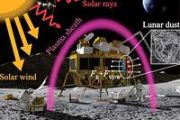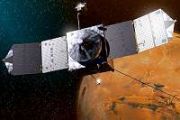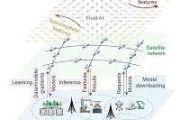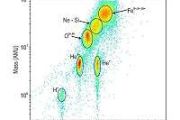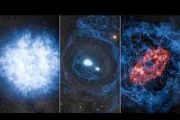
Copernical Team
Iridium wins five year US Space Force contract to upgrade EMSS infrastructure
 Iridium Communications Inc. has secured a five year indefinite delivery and indefinite quantity contract from the US Space Force Space Systems Command Commercial Space Office worth up to 85.8 million dollars.
The System Infrastructure Transformation and Hybridization contract covers technology refreshes, lifecycle upgrades, and security improvements for the Enhanced Mobile Satellite Servic
Iridium Communications Inc. has secured a five year indefinite delivery and indefinite quantity contract from the US Space Force Space Systems Command Commercial Space Office worth up to 85.8 million dollars.
The System Infrastructure Transformation and Hybridization contract covers technology refreshes, lifecycle upgrades, and security improvements for the Enhanced Mobile Satellite Servic JWST spots early Milky Way style spiral galaxy Alaknanda
 Astronomers using NASAs James Webb Space Telescope have identified a massive spiral galaxy that resembles the Milky Way but existed when the Universe was only about 1.5 billion years old. Named Alaknanda, after a Himalayan river paired with the Mandakini which shares its Hindi name with the Milky Way, the system appears as a mature, disk dominated spiral at a time when galaxies were expected to
Astronomers using NASAs James Webb Space Telescope have identified a massive spiral galaxy that resembles the Milky Way but existed when the Universe was only about 1.5 billion years old. Named Alaknanda, after a Himalayan river paired with the Mandakini which shares its Hindi name with the Milky Way, the system appears as a mature, disk dominated spiral at a time when galaxies were expected to Cosmic rays drive urgent search for better protection before crewed trips to Mars
 The first step on the Moon was one of humanity's most exciting accomplishments. Now scientists are planning return trips - and dreaming of Mars beyond.
Next year, Nasa's Artemis II mission will send four astronauts to fly around the Moon to test the spacecraft before future landings. The following year, two astronauts are expected to explore the surface of the Moon for a week as part of Na
The first step on the Moon was one of humanity's most exciting accomplishments. Now scientists are planning return trips - and dreaming of Mars beyond.
Next year, Nasa's Artemis II mission will send four astronauts to fly around the Moon to test the spacecraft before future landings. The following year, two astronauts are expected to explore the surface of the Moon for a week as part of Na SPHERE debris disk survey maps hidden asteroid and comet belts in young planetary systems
 Observations with the SPHERE instrument on ESO's Very Large Telescope have produced a large gallery of debris disks around nearby young stars, revealing where unseen asteroid- and comet-scale bodies are colliding and generating dust. Gael Chauvin, SPHERE project scientist and co-author, said: "This data set is an astronomical treasure. It provides exceptional insights into the properties of debr
Observations with the SPHERE instrument on ESO's Very Large Telescope have produced a large gallery of debris disks around nearby young stars, revealing where unseen asteroid- and comet-scale bodies are colliding and generating dust. Gael Chauvin, SPHERE project scientist and co-author, said: "This data set is an astronomical treasure. It provides exceptional insights into the properties of debr NASA desert drone trials refine navigation software for future Mars explorers
 To prepare new autonomous systems for Mars, NASA teams have been testing drones, a legged robot, and a winged flyer concept in harsh desert environments in California, New Mexico, and Virginia. The work is part of 25 Mars Exploration Program technology projects funded this year to extend the reach and capability of future Red Planet missions.
At Death Valley National Park and in the nearby
To prepare new autonomous systems for Mars, NASA teams have been testing drones, a legged robot, and a winged flyer concept in harsh desert environments in California, New Mexico, and Virginia. The work is part of 25 Mars Exploration Program technology projects funded this year to extend the reach and capability of future Red Planet missions.
At Death Valley National Park and in the nearby Bacterial partnership offers pathway to produce Mars regolith bricks for future habitats
 Human missions to Mars will require robust shelters that can be built without hauling heavy materials from Earth, pushing engineers and scientists to focus on in situ resource utilization of the planet's regolith. A new perspective article describes how carefully selected microbial communities could turn Martian dust into structural elements for habitats, while also contributing to life-support
Human missions to Mars will require robust shelters that can be built without hauling heavy materials from Earth, pushing engineers and scientists to focus on in situ resource utilization of the planet's regolith. A new perspective article describes how carefully selected microbial communities could turn Martian dust into structural elements for habitats, while also contributing to life-support Micro nano robots aim to cut carbon buildup in closed life support systems
 Researchers have developed micro and nanoscale reconfigurable robots that capture and release carbon dioxide in confined life support systems such as crewed spacecraft, submarines, and sealed shelters. The team led by Prof. Hui He at Guangxi University reports that these micro nano reconfigurable robots, or MNRM, use sunlight as an energy source while moving through the system to avoid local ove
Researchers have developed micro and nanoscale reconfigurable robots that capture and release carbon dioxide in confined life support systems such as crewed spacecraft, submarines, and sealed shelters. The team led by Prof. Hui He at Guangxi University reports that these micro nano reconfigurable robots, or MNRM, use sunlight as an energy source while moving through the system to avoid local ove LandSpace ZQ 3 Y1 rocket reaches orbit on first reusable flight attempt
 LandSpace, a private Chinese rocket company, has flown its ZQ 3, or Rosefinch 3, carrier rocket for the first time, marking China's initial orbital mission using a reusable rocket architecture, although recovery of the first-stage booster was not successful.
The ZQ 3 Y1 vehicle, built mainly from stainless steel, lifted off at noon from a dedicated launch service tower at the Jiuquan Satel
LandSpace, a private Chinese rocket company, has flown its ZQ 3, or Rosefinch 3, carrier rocket for the first time, marking China's initial orbital mission using a reusable rocket architecture, although recovery of the first-stage booster was not successful.
The ZQ 3 Y1 vehicle, built mainly from stainless steel, lifted off at noon from a dedicated launch service tower at the Jiuquan Satel A martian butterfly flaps its wings

Is it an insect? A strange fossil? An otherworldly eye, or even a walnut? No, it’s an intriguing kind of martian butterfly spotted by ESA’s Mars Express.
China consolidates new commercial space regulator and industry roadmap
 The China National Space Administration has set up a Commercial Space Department to serve as a dedicated regulator for the country's expanding private space sector. The new office is responsible for overseeing commercial launches, satellite operations, and related services while coordinating policy and planning for non-state space activities.
Officials have tied the move to the Action Plan
The China National Space Administration has set up a Commercial Space Department to serve as a dedicated regulator for the country's expanding private space sector. The new office is responsible for overseeing commercial launches, satellite operations, and related services while coordinating policy and planning for non-state space activities.
Officials have tied the move to the Action Plan 





